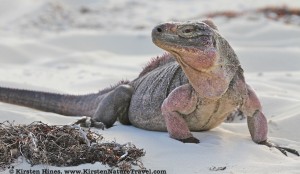
Kirsten Hines
Iguanas in the Exumas (Provided by Kirsten Hines; www.kirstennaturetravel.com)
The Exuma Islands of the Bahamas are home to two endemic subspecies of Northern Bahamian Rock Iguanas (Cyclura cychlura), members of one of the most charismatic and endangered lizard genera on the planet. The Allen Cay Rock Iguana (C. c. inornata) is native only to Leaf and Southwest Allen’s Cays in the Allen’s Cays grouping, just northwest of Highbourne Cay, and is IUCN (International Union for Conservation of Nature and Natural Resources) listed as endangered. The Exuma Island Rock Iguana (C. c. figginsi) is native to eight islands distributed between Staniel and Great Exuma Cays and is IUCN listed as critically endangered. Externally the two subspecies look virtually identical, as do males and females, though adult males attain a slightly larger maximum body size.
These lizards are the largest, natural land vertebrate in the Bahamas and are primarily vegetarian. Smaller-sized iguanas may frequently be seen foraging in trees, but larger adults spend most of their time on the ground. And unlike the more commonly known Green Iguana (Iguana iguana), who is highly arboreal and willfully spends time in the water, these iguanas swim only short distances when forced to. They can live 40 or more years and at least the females don’t reach sexual maturity until 12 years of age.
In the early to mid-1900’s these iguanas were particularly threatened by poaching, and for a time the Allen’s Cays subspecies was considered extinct. The passing of the Wild Animals Protection Act by the Bahamian government in the late 1960’s helped alleviate hunting pressures, as did increased visits from tourists, and the populations have rebounded since. With their recovered numbers, these iguanas are an increasingly popular tourist attraction with iguanas on some islands being visited and fed nearly every day of the year. It is unclear what the long-term impact of this food supplementation is, but demographic, behavioral, dietary and physiological differences between fed and non-fed populations have already been noted (Iverson et al. 2006, James et al. 2006, Hines 2011, Knapp et al. in prep). It is important that we understand the implications of these changes in order to manage for the long-term survival of these unique iguanas.
For more information see: Kirsten Hines Research
Iguana Feeding Study
Cruisers, here is a chance to help out a study of the feeding habits of iguanas.
From Kirsten Hines:
Northern Bahamian Rock Iguanas (Cyclura cychlura) endemic to the Exuma Islands of the Bahamas are an increasingly popular tourist attraction, enticing speed-boat based tour groups from nearby towns and cities to feed these accepting recipients. Leaf Cay in the Allen’s Cays, the most heavily visited island, now receives 100 or more visitors in a day and the iguanas have become accustomed to being fed.
Please help with the conservation of this species by sharing with me observations of Rock Iguanas in the Exumas taking unusual food, hunting or scavenging. Please report your behavioral or dietary observation, along with the date and location of the observation, to Kirsten Hines at KirstenNatureTravel@gmail.com. I would greatly appreciate any information you might have to contribute and will acknowledge all contributions.
For more information see: Kirsten Hines Research
Updated:29 Mar 13